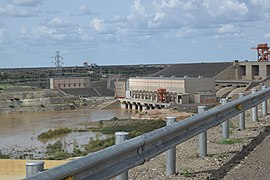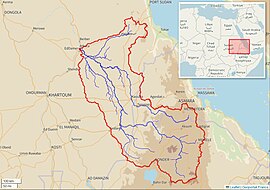Sông Atbarah
| Sông Atbarah | |
|---|---|
 Upper Atbara and Setit Dam Complex Hydroelectric Power Plant | |
 Atbarah River Basin (Interactive map) | |
| Vị trí | |
| Countries | |
| Đặc điểm địa lý | |
| Cửa sông | |
• vị trí | Discharges into theNile |
• tọa độ | 17°40′41″B33°58′25″Đ/ 17,6781°B 33,9735°Đ |
| Độ dài | 805 kilômét (500 mi) |
| Diện tích lưu vực | 69.000 kilômét vuông (27.000 dặm vuông Anh) |
| Lưu lượng | |
| • trung bình | 374 m3/s (13.200 cu ft/s) |
Sông Atbarah(tiếng Ả Rập:نهر عطبرة;transliterated:Nahr 'Atbarah), còn được biết đến với tênSông Nile ĐỏhaySông Nile Đen,là một con sông ở phía đông bắcchâu Phi.Nó khởi nguồn từ phía tây bắcEthiopia,cáchHồ Tanakhoảng 50 km về phía bắc và cáchGondar30 km về phía tây. Sau đó sông trải dài khoảng 805 km (500 mi) trước khi đến hợp lưu sôngNileở vùng trung bắcSudan,tại vị trí đô thịAtbarah(17°40′37″B33°58′12″Đ/ 17,677°B 33,97°Đ). Cácphụ lưubao gồmsông Tekezé,có lẽ là phần khởi nguồn của Atbarah, vì sôngTekezé chảy một đoạn dài trước khi hợp lưu hai con sông tại (at 14° 10' N, 36° E) đông bắc Sudan. Sông Atbarah là phụ lưu cuối của sông Nile trước khi sông đổ raĐịa trung hải.
Trong phần lớn thời gian các năm, lưu lượng dòng sông này chỉ lớn hơn một dòng suối nhỏ. Tuy nhiên trong mùa mưa (từ tháng 7 đến tháng 10), mực nước sông Atbarah có khi dâng cao đến 18 ft (5 m) so với mực nước thông thường. Tại thời điểm này, con sông trở thành hàng rào tự nhiên ngăn cách phía bắc và nam củaAmhara (vùng)thuộc Ethiopia. Besides the Tekezé, other important tributaries of the Atbarah include theShinfa Riverwhich rises west of Lake Tana, and theGreater Angerebwhich has its source north of the city ofGondar.
Lịch sử
[sửa|sửa mã nguồn]The earliest surviving mention of the Atbarah is byStrabo(16.4.8), who called the riverAstaboras(tiếng Hy Lạp:Ασταβόρας).[1]Other ancient authors mentioning the name includeAgatharchides,who called itAstabaras(tiếng Hy Lạp:Ασταβάρας),[1]andPtolemy(Geography4.7).[2]Richard Pankhurstand others have argued that the name should be understood as "River of the Boras people", whereastacan be related to Proto-Nubianasti"water",[1]while-borascan be linked to a number of Roman allusions to a tribe named the Bora (Bera), who lived nearMeroe,[3]and another tribe named theMegabares(tiếng Hy Lạp:Μεγάβαροιin Eratosthenes and Strabo,tiếng Latinh:MegabarriinPliny the Elder).[1]Pliny the Elderprovides a slightly different etymology of Astaboras, stating that "in the language of the local people" the name means "water coming from the shades below" (N.H.5.10).
In April 1898 a majorbattlewas fought beside the river during theAnglo-Egyptian invasion of Sudan 1896–1899betweenMahdistforces and an Anglo-Egyptian Army under the command ofLord Kitchener,which resulted in the destruction of the 20,000-strong Mahdist detachment.[4]
In 1964, the river was dammed by theKhashm el-Girba DamnearKassalain Sudan to provide irrigation to the newly built town of Halfa Dughaym in an otherwise fairly arid region and to resettle the Sudanese population driven away by theAswan High Dam(Sad al-Aali) in Egypt, which flooded 500 km of the Nile Valley in southern Egypt and northern Sudan.[5]
Construction on a $1.9 billion twin dam project about 20 km upstream from the confluence of the Upper Atbara and Setit rivers, theRumela and Burdana dams,began in 2011 and was inaugurated by PresidentOmar al-Bashirin February 2017.[6]
Hydrology
[sửa|sửa mã nguồn]Average monthly flow (1912–1982) of the Atbarah measured approximately 25 km upstream of its mouth, measured in m3/s:[7]

Xem thêm
[sửa|sửa mã nguồn]Tham khảo
[sửa|sửa mã nguồn]- ^abcdClaude Rilly, Le méroïtique et sa famille linguistique, Peeters, Louvain 2010, p. 179
- ^“LacusCurtius • Ptolemy's Geography — Book IV, Chapter 7”.Penelope.uchicago.edu.Truy cập ngày 10 tháng 12 năm 2013.
- ^Richard Pankhurst,The Ethiopian Borderlands(Lawrenceville: Red Sea Press, 1997), p. 27
- ^Winston Churchill(1899).The River War Volume 1.Longmans. tr. 416 Chapter XIII.
- ^Hurni, Hans; Tato, Kebede; Zeleke, Gete (tháng 5 năm 2005).“The Implications of Changes in Population, Land Use, and Land Management for Surface Runoff in the Upper Nile Basin Area of Ethiopia”.Mountain Research and Development.25(2): 147–154.doi:10.1659/0276-4741(2005)025[0147:tiocip]2.0.co;2.ISSN0276-4741.
- ^Gregory B. Poindexter (2 tháng 2 năm 2017).“Sudan inaugurates US$1.9 billion Upper Atbara and Setit Dam hydropower project”.HydroWorld.Truy cập ngày 4 tháng 11 năm 2018.
- ^“Nile - Kilo 3”.University of New Hampshire. 26 tháng 2 năm 2000.
Liên kết ngoài
[sửa|sửa mã nguồn]| Wikimedia Commons có thêm hình ảnh và phương tiện truyền tải vềSông Atbarah. |
- Maps of Ethiopia- Perry–Castañeda Library Map Collection,University of Texas
